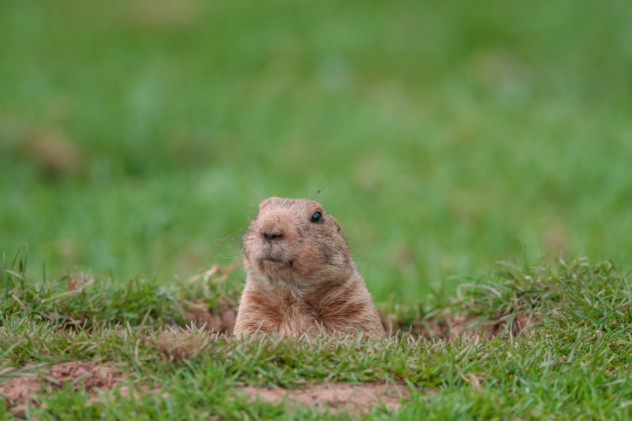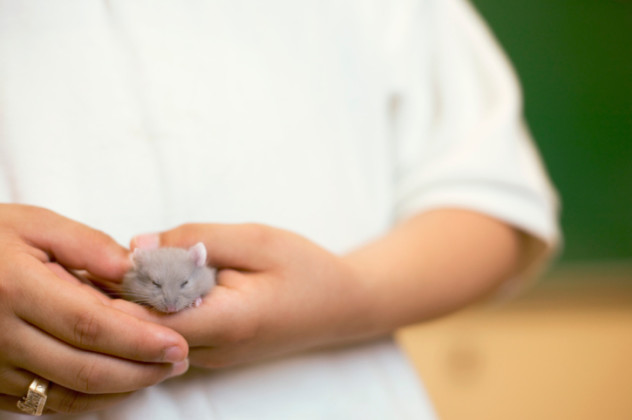 Weird Stuff
Weird Stuff  Weird Stuff
Weird Stuff  Our World
Our World 10 Ways Your Christmas Tree Is More Lit Than You Think
 Movies and TV
Movies and TV The 10 Coolest Stars to Set Sail on The Love Boat
 History
History 10 Things You Didn’t Know About the American National Anthem
 Technology
Technology Top 10 Everyday Tech Buzzwords That Hide a Darker Past
 Humans
Humans 10 Everyday Human Behaviors That Are Actually Survival Instincts
 Animals
Animals 10 Animals That Humiliated and Harmed Historical Leaders
 History
History 10 Most Influential Protests in Modern History
 Creepy
Creepy 10 More Representations of Death from Myth, Legend, and Folktale
 Technology
Technology 10 Scientific Breakthroughs of 2025 That’ll Change Everything
 Weird Stuff
Weird Stuff Ten Bizarre Facts About The Doge Meme
 Our World
Our World 10 Ways Your Christmas Tree Is More Lit Than You Think
 Movies and TV
Movies and TV The 10 Coolest Stars to Set Sail on The Love Boat
Who's Behind Listverse?

Jamie Frater
Head Editor
Jamie founded Listverse due to an insatiable desire to share fascinating, obscure, and bizarre facts. He has been a guest speaker on numerous national radio and television stations and is a five time published author.
More About Us History
History 10 Things You Didn’t Know About the American National Anthem
 Technology
Technology Top 10 Everyday Tech Buzzwords That Hide a Darker Past
 Humans
Humans 10 Everyday Human Behaviors That Are Actually Survival Instincts
 Animals
Animals 10 Animals That Humiliated and Harmed Historical Leaders
 History
History 10 Most Influential Protests in Modern History
 Creepy
Creepy 10 More Representations of Death from Myth, Legend, and Folktale
 Technology
Technology 10 Scientific Breakthroughs of 2025 That’ll Change Everything
10 Most Lovable Animals That Can Become Gruesome Cannibals
It’s a known truth that everyone simply adores cute animals. Even the coldest of hearts can be melted by playful little puppies, and a flock of ducklings waddling along is sure to bring a smile to anyone’s face. But just like every other species, these cuddly little critters certainly have their vices. Each of these lovable animals enjoys a rather different kind of diet—all of them regularly practice cannibalism. Cannibalism happens when one member of a species willingly eats other members of the same species, and in many of these cases, it involves the violent murder of friends or family. Even so, the fact that these animals are homicidal maniacs doesn’t change the fact that they look adorable.
10 Prairie Dogs

If all of your sisters have kids with your husband, it’s okay to eat the kids, right? Out on the American plains, prairie dogs certainly seem to think so. These adorable burrowing creatures may not be so friendly after all, despite their reputation as our classic furry friends. One seven-year study published in the 1980s showed that acts of cannibalism in colonies of black-tailed prairie dogs caused the deaths of some offspring in 51 percent of all litters.
A typical coterie—the name for a family of prairie dogs—is made up of one male, several females, and all the juvenile offspring of the group. Interestingly enough, the cannibalism most often occurs when lactating females in the coterie eat the young of the other females. This means that many end up eating their own nieces and nephews. Some suggest that these violent acts might be efforts to control population density in the colony, but it may be that the nursing mothers are simply desperate for something to eat.
The prairie dogs’ actions become even more twisted, however, weeks after the killing spree—many females attempt to nurse the very same prairie dog pups that they had tried to eat not long before. Thus, the mass murders of the spring are soon forgotten, and the prairie dogs go back to their simple lives as cute, furry herbivores.
9 Hermit Crabs

Life can be pretty boring for a hermit crab, but when something special happens, like the brutal death of another crab, it’s cause for celebration! Hermit crabs certainly seem to be harmless, with their small size and shy nature. When it comes down to survival instincts, though, the crustaceans can be downright savage. When hermit crabs go through a molting stage, they lose their exoskeletons that give them protection. They quickly become prey to other crabs in the area and are often attacked and eaten for food. Extremely aggressive crabs won’t even wait for this stage; instead, they will try to rip off a fellow crab’s shell and take it for themselves.
Perhaps what truly underlies all this violent behavior, though, is the zealous attitude that the crabs take on. Recent studies have shown that when hermit crabs sense the smell of dead crabs, they immediately become excited and start to hunt for food. Often, the most readily available food is the next hermit crab.
8 Tadpoles

Growing up is a time of great change and opportunity in a tadpole’s life. Every day, these amphibious babies meet someone new who might try to puncture their lungs and eat them. In the pond, eating your own kind alive isn’t really a problem for the tadpoles. Studies have shown that tadpoles will eat each other if no better food options are available. Even if there is better food around, though, tadpoles still have to be on the watch when they’re in densely packed groups. In these conditions, one or more tadpoles may attack another in a deadly competition—each one is fighting for a chance to reach adulthood, and knocking out other competitors increases their odds of survival.
Sometimes, these tadpoles’ frog fathers will even deliver them to an area where they are more likely to be eaten by others, a parenting method that would make any human cringe. The fathers drop their children off in ponds where several larger tadpoles also live, possibly because the living conditions of the pond must be good if others are thriving in there. However, this usually only serves to increase the newborn tadpoles’ chance of death, as they are often eaten by the other inhabitants. Childhood and adolescence are rough times for everyone, but at least most species don’t have to worry about being eaten alive by their friends.
7 Hedgehogs

In a hedgehog’s world, there is a surefire method that can help to deal with fear: keep calm and devour your newborn babies. These endearing, spiky animals are commonly kept as pets, but many owners don’t realize that hedgehogs often turn cannibal when breeding time comes around. These timid creatures get scared very easily, especially right after a mother has given birth. First of all, the presence of another male hedgehog right after breeding creates tension among the hedgehog family. Second, when kept in captivity, nearly any disturbance can be extremely frightening for a hedgehog, causing them to become stressed out. Finally, a cramped or small living area can lead to aggressive behavior.
All of these factors often cause one or both hedgehog parents to take drastic measures. If either parent has the slightest inkling of fear, it will not hesitate to abandon or even eat its own newborn babies. In some ways, the hedgehogs just use their children as comfort food in times of distress.
6 Ducklings

It’s impossible not to love these cuddly birds, and no one can resist watching a flock of ducklings waddling around. Many don’t realize, however, that ducks aren’t opposed to cannibalism, even at a young age. Ducklings that are only four weeks old can develop the practice of eating other ducklings.
What’s even more surprising is the motivation behind this cruelty. Cannibalism may simply be spurred on by boredom. Of course, other factors such as crowding, poor ventilation, and a lack of nutrients can contribute to a duckling’s urge to eat other ducklings. These poultry are prone to pecking and tearing at each other before eating parts of other ducklings. They also like to imitate each other, so acts of aggression and cannibalism spread quickly throughout a flock. As more and more ducklings join in the fun, a flock can easily tally up high death toll.
5 Cats

Life as a kitten sure is easy. A newborn kitten gets to play with yarn and nestle with its siblings, and it only occasionally has to worry about one of its parents eating it. Domestic cats are extremely common pets that live in households all over the world, but many don’t realize that kittens are at a substantial risk for being eaten by older cats, even their parents. Cannibalism actually is the cause of 12.5 percent of all preweaned kitten deaths. If a mother senses that her kitten might be ill or is deformed in some way, she will immediately kill and eat it in order to save resources for other kittens and protect the others from possible diseases.
Even more disturbing, however, are the ways that male cats sometimes kill kittens. After giving birth, a female cat will sometimes have a surge in hormones that nearby toms may mistake for an invitation to mate. This causes them to become sexually aroused, but the female will obviously reject any advances because she isn’t actually ready to mate yet. Since the male is already in a state of arousal and is slightly confused, he will try to mate with the kittens. When he figures out that the kittens are too small to mate with, he may bite their necks in disapproval, which can easily kill them.
It’s bad enough that kittens have to be wary of a strict mother, but it’s even worse that they have to be on the watch for sexually overbearing and violent males. It’s a tough life, being a kitten, even if you do get to be adorable all the time.
4 Dogs

Eating your newborn children because you thought they were rats really is an honest mistake, and we can respect that. Dog lovers may be shocked to find that dogs would dare to kill and eat their own children, but it can happen for a number of reasons. Similarly to mother cats, they might do this if they sense that a puppy is sick or deformed, or if they feel nervous or stressed after giving birth. An imbalance of hormones in the mother might also cause her to neglect her children or cause depression, and this may lead to the mother killing her entire litter.
What’s really strange, though, is that mothers sometimes eat their puppies simply because they don’t recognize them. In fact, some mothers mistake their newborn puppies for rodents because of their fitful movements and squealing. Puppies are some of the most adored and coddled creatures in the world, but moody or memory-challenged mothers might not be so endeared.
3 Caterpillars

Becoming a butterfly takes a lot of hard work and energy, so devouring undeveloped siblings for a nutritional boost certainly isn’t out of the question for caterpillars. These familiar little bugs love to happily munch away until they eventually go through the stages of becoming beautiful butterflies. Caterpillars can become dangerous, however, when their case of the munchies gets a little out of hand. Even if they haven’t run out of their customary plants to eat, caterpillars have been known to eat butterfly eggs.
Cannibalism can help caterpillars in two ways. First, it weeds out the competition so that caterpillars in close proximity don’t have to fight for food. Second, eating the eggs of your own species has significant nutritional benefits for caterpillars. For example, one species of moth caterpillar can find pyrrolizidine alkaloid—an important defensive agent—in eggs of other moth caterpillars if they need more of it in their system. So really, there aren’t many disadvantages to blatant cannibalism when you’re a caterpillar. If eating your fellow unborn kind helps to become a magnificent butterfly, then why not try it?
2 Hamsters

Hamsters may be some of the cutest rodents alive, but that doesn’t stop them from acting murderously every once in a while. While other animals may cannibalize with generally good intentions or simply by misunderstanding, hamsters can be pretty selfish in their motives for murder.
Hamsters are very territorial, so some will kill and eat anyone that dares to live in the same cage. And of course, as in many other cases, mothers will often eat their young. This is extremely common in hamsters. One study showed that over 75 percent of hamster mothers ate part of their litters fairly soon after giving birth, and another survey showed that cannibalism accounted for 97.5 percent of all preweaned hamster deaths. Hamster mothers will do this in order to conserve resources because they know how many babies they can actually take care of, a number often smaller than the number of baby hamsters in a litter. As a plus, the eaten babies provide extra protein for her in a taxing time of nursing.
But hamsters don’t cannibalize just any random baby. No, they’re far more selective. Studies show that hamsters actually prefer to eat their female babies instead of the males. It’s a strange thing for a mother hamster to practice apparent misogyny, but perhaps she does this because she thinks males have a better chance of surviving. Either way, it’s pretty disturbing to think of these tiny fluff balls gleefully slaughtering their children and roommates.
1 Ladybugs

None of us want to believe that ladybugs could possibly belong on this list, or that these itty bitty insects would ever try to hurt anything. The cold, hard truth is that they do practice cannibalism, and that they are rewarded for doing so. One study found that ladybugs that eat other ladybugs have higher chances of survival and develop more quickly. There’s also a benefit in eating others that have eaten better food, as the superior nutrition gets passed on to the murderous ladybug.
Even more disturbingly, these cannibals like to prey on the weak. The most vulnerable targets tend to be ladybugs that can’t move or have a soft exoskeleton because of the growth stage they are in. They also tend to be more cannibalistic when far from home. If ladybugs aren’t in their natural habitat and are invading new lands, then they are much more likely to eat other ladybugs instead of sticking to their normal diets. Next time someone picks up one of these pretty little bugs again, feel free to give them a friendly reminder that it might be in the process of digesting one of its little friends.
Kiran is an enthusiastic writer with her own unique sense of humor.








